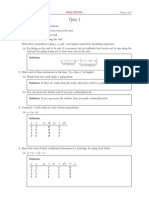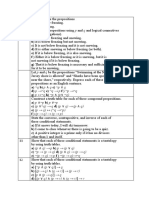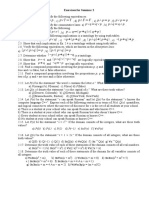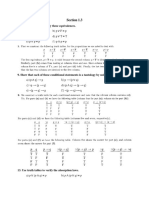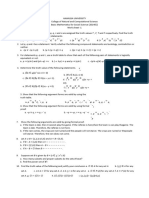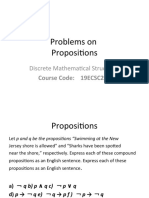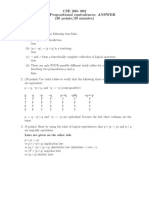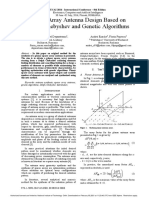0 ratings0% found this document useful (0 votes)
20 viewsTutorial 3
Tutorial 3
Uploaded by
Divyanshu BoseThe document outlines the topics to be covered in Tutorial 3, including:
1) Proving inferences using rules of inference
2) Converting logical statements to conjunctive normal form (CNF)
3) Using resolution to determine which logical statements are tautologies
4) Converting sentences to clausal form
5) Applying propositional resolution to pairs of clauses
6) Using propositional resolution to show that a set of clauses is not simultaneously satisfiable
7) Using propositional resolution to prove a conclusion from given premises
Copyright:
© All Rights Reserved
Available Formats
Download as PDF, TXT or read online from Scribd
Tutorial 3
Tutorial 3
Uploaded by
Divyanshu Bose0 ratings0% found this document useful (0 votes)
20 views2 pagesThe document outlines the topics to be covered in Tutorial 3, including:
1) Proving inferences using rules of inference
2) Converting logical statements to conjunctive normal form (CNF)
3) Using resolution to determine which logical statements are tautologies
4) Converting sentences to clausal form
5) Applying propositional resolution to pairs of clauses
6) Using propositional resolution to show that a set of clauses is not simultaneously satisfiable
7) Using propositional resolution to prove a conclusion from given premises
Copyright
© © All Rights Reserved
Available Formats
PDF, TXT or read online from Scribd
Share this document
Did you find this document useful?
Is this content inappropriate?
The document outlines the topics to be covered in Tutorial 3, including:
1) Proving inferences using rules of inference
2) Converting logical statements to conjunctive normal form (CNF)
3) Using resolution to determine which logical statements are tautologies
4) Converting sentences to clausal form
5) Applying propositional resolution to pairs of clauses
6) Using propositional resolution to show that a set of clauses is not simultaneously satisfiable
7) Using propositional resolution to prove a conclusion from given premises
Copyright:
© All Rights Reserved
Available Formats
Download as PDF, TXT or read online from Scribd
Download as pdf or txt
0 ratings0% found this document useful (0 votes)
20 views2 pagesTutorial 3
Tutorial 3
Uploaded by
Divyanshu BoseThe document outlines the topics to be covered in Tutorial 3, including:
1) Proving inferences using rules of inference
2) Converting logical statements to conjunctive normal form (CNF)
3) Using resolution to determine which logical statements are tautologies
4) Converting sentences to clausal form
5) Applying propositional resolution to pairs of clauses
6) Using propositional resolution to show that a set of clauses is not simultaneously satisfiable
7) Using propositional resolution to prove a conclusion from given premises
Copyright:
© All Rights Reserved
Available Formats
Download as PDF, TXT or read online from Scribd
Download as pdf or txt
You are on page 1of 2
Tutorial 3 Date : 31th August 2020
1. Prove using rules of inference :
2. Convert to CNF
(a) ¬(p ↔ q)
(b) ((p → q) ∧ q) → p
(c) (p ↔ q) ↔ r
(d) p → ( q ↔ r)
(e) (¬p ∧ ( q ↔ p)) → ((q ∧ p) ∨ p)
3. Using the method of resolution check which of the following formulae are tautologies.
(a) ((p → q) → q) → q
(b) ((q → p) → q) → q
(c) ((p → q) ∧ (p → q)) → p
(d) ((p ∨ q) → r) → ( q ∧ r)
(e) ((p → q) ∧ (p → r)) → (p → (q ∧ r))
(f) ((p → r) ∧ (q → r)) → ((p ∧ q) → r)
(g) ((p → r) ∨ (q → r)) → ((p ∨ q) → r)
(h) ((p → r) ∧ (q → r)) → ((p ∨ q) → r)
(i) p → ((q → r) → ((p → q) → r))
(j) (p → (q → r)) → ((p → q) → (p → r))
4. Convert the following sentences to clausal form.
(a) p ∧ q ⇒ r ∨ s
(b) p ∨ q ⇒ r ∨ s
(c) ¬(p ∨ q ∨ r)
(d) ¬(p ∧ q ∧ r)
(e) p ∧ q ⇔ r
5. What are the results of applying Propositional Resolution to
the following pairs of clauses.
(a) {p, q, ¬r} and {r, s}
(b) {p, q, r} and {r, ¬s, ¬t}
(c) {q, ¬q} and {q, ¬q}
{¬p, q, r} and {p, ¬q,
(d)
¬r}
6. Use Propositional Resolution to show that the clauses {p, q},
{¬p, r}, {¬p, ¬r}, {p, ¬q} are not simultaneously satisfiable.
7. Given the premises (p ⇒ q) and (r ⇒ s), use Propositional
Resolution to prove the conclusion (p ∨ r ⇒ q ∨ s).
You might also like
- 1 Discrete PDFDocument25 pages1 Discrete PDFBobi NathNo ratings yet
- Name of The Student: Branch: Unit - I (Logic and Proofs)Document11 pagesName of The Student: Branch: Unit - I (Logic and Proofs)Dhilip PrabakaranNo ratings yet
- Quiz1 Solutions PDFDocument2 pagesQuiz1 Solutions PDFNoel Murti100% (1)
- ProblemsDocument39 pagesProblemscalifaunaNo ratings yet
- P: It Is Below Freezing. Q: It Is SnowingDocument2 pagesP: It Is Below Freezing. Q: It Is SnowingShantala GiraddiNo ratings yet
- Logic and ProofsDocument7 pagesLogic and ProofsDmdhineshNo ratings yet
- Mathematical ReasoningDocument83 pagesMathematical Reasoningsahaana.23.kNo ratings yet
- Handout 2 2023Document3 pagesHandout 2 2023Naids TeachNo ratings yet
- 094 - MA8351, MA6566 Discrete Mathematics - Important QuestionsDocument39 pages094 - MA8351, MA6566 Discrete Mathematics - Important QuestionsSasi BalajiNo ratings yet
- Exercises For Seminar and Homework 2Document2 pagesExercises For Seminar and Homework 2Bimukhanbet AitmaganbetNo ratings yet
- Discrete Mathematics: (COMP2121B)Document20 pagesDiscrete Mathematics: (COMP2121B)Brandon TayNo ratings yet
- Assgn1 PDFDocument2 pagesAssgn1 PDFfuckitNo ratings yet
- Exercisessection1 3solutionDocument3 pagesExercisessection1 3solutionIMRAN USSINo ratings yet
- HW 1 SolutionDocument5 pagesHW 1 SolutionShakeel BhattiNo ratings yet
- Tautologies PDFDocument1 pageTautologies PDFmaqw123No ratings yet
- Tautologies PDFDocument1 pageTautologies PDFJose GramophoneManNo ratings yet
- Tautologies PDFDocument1 pageTautologies PDFmaqw123No ratings yet
- Work Sheet 1Document12 pagesWork Sheet 1yeabtsegabereket091100% (1)
- Math207_wrksheet1Document2 pagesMath207_wrksheet1Kaphenzu WorldNo ratings yet
- @freshmanexams NAGHMC Maths Worksheet 1Document9 pages@freshmanexams NAGHMC Maths Worksheet 1abduloro370No ratings yet
- (X R: X 5) and CS (X R: 0 X 15) - Find and Graph Each of The Following Solution SetDocument3 pages(X R: X 5) and CS (X R: 0 X 15) - Find and Graph Each of The Following Solution SetMayra SofíaNo ratings yet
- Rules of Inference:: Any of The Following Logically Equivalent Expressions Can Replace Each Other Wherever They OccurDocument3 pagesRules of Inference:: Any of The Following Logically Equivalent Expressions Can Replace Each Other Wherever They OccurAmita Angellae GuimNo ratings yet
- pDocument3 pagespsyum amareNo ratings yet
- PropositionsDocument25 pagesPropositionsShantala GiraddiNo ratings yet
- Discrete Math Lab 2 With AnswerDocument12 pagesDiscrete Math Lab 2 With AnswerMizoo MahmoudNo ratings yet
- Ma 161: Discrete Mathematics I Faculty of Science, Technology & Environment School of Computing, Information & Mathematical SciencesDocument7 pagesMa 161: Discrete Mathematics I Faculty of Science, Technology & Environment School of Computing, Information & Mathematical SciencesSanjeeta DeoNo ratings yet
- Clase 23-10 Deducción NaturalDocument4 pagesClase 23-10 Deducción NaturalIsrael FloresNo ratings yet
- Equivalence ProblemsDocument2 pagesEquivalence ProblemsRomalyn GalinganNo ratings yet
- COMS1016 Lecture 5 SolutionsDocument4 pagesCOMS1016 Lecture 5 SolutionsThembisile ThusiNo ratings yet
- Propositional CalculusDocument9 pagesPropositional CalculusRaj JoshiNo ratings yet
- Discrete Mathematics-Exercises 2Document65 pagesDiscrete Mathematics-Exercises 2lamhuynhhueman.pthtNo ratings yet
- Math For NS Worksheet 8 (Chapter 1)Document9 pagesMath For NS Worksheet 8 (Chapter 1)Yohannes WorkuNo ratings yet
- Distrect assignnment 41Document4 pagesDistrect assignnment 41PashalNo ratings yet
- Important Equivalences in Propositional LogicDocument1 pageImportant Equivalences in Propositional LogicCurt FreeNo ratings yet
- Solution1 10Document5 pagesSolution1 10tntxp256No ratings yet
- CSE 260-002 QUIZ-2 - Propositional Equivalences - ANSWER (30 Points/20 Minutes)Document2 pagesCSE 260-002 QUIZ-2 - Propositional Equivalences - ANSWER (30 Points/20 Minutes)Joseph Jessie Sapinoso OñateNo ratings yet
- Logics PDFDocument2 pagesLogics PDFAdriana LimaNo ratings yet
- Discrete+Structures+Final+Paper+Fall+2018+ +solnDocument13 pagesDiscrete+Structures+Final+Paper+Fall+2018+ +solnK213156 Syed Abdul RehmanNo ratings yet
- 2023 ELyMD P1Document2 pages2023 ELyMD P1maximoemiliano233No ratings yet
- TMF1814 Tutorial 5 AnsDocument6 pagesTMF1814 Tutorial 5 AnsDemus JohneyNo ratings yet
- Test 1Document3 pagesTest 1ommprasadsikuNo ratings yet
- A1 SolDocument8 pagesA1 SolMeyssa SmiraniNo ratings yet
- 2024 ELyMD P2Document4 pages2024 ELyMD P2emilianobarrientos54No ratings yet
- DM I MID QBDocument12 pagesDM I MID QBbhuvanvasa23sNo ratings yet
- Assignment 1: Discrete Structure BS (CS) Propositional Logic 13th March 2022Document1 pageAssignment 1: Discrete Structure BS (CS) Propositional Logic 13th March 2022Nouman AbbasiNo ratings yet
- Poriyaan 1B5ZTkoJI TWxguYhUcbkYpbrtchRpZ7X PDFDocument43 pagesPoriyaan 1B5ZTkoJI TWxguYhUcbkYpbrtchRpZ7X PDFHarsha VarthiniNo ratings yet
- COMP9414: Artificial Intelligence - Solutions Week 5 Propositional LogicDocument4 pagesCOMP9414: Artificial Intelligence - Solutions Week 5 Propositional LogicHồ Nguyễn Quang DuyNo ratings yet
- 3432Document2 pages3432naoltujuba383No ratings yet
- Discrete MathematicsDocument16 pagesDiscrete MathematicsMathankumar RNo ratings yet
- Discrete MathematicsDocument2 pagesDiscrete Mathematics90's SusiNo ratings yet
- Note03 1x2Document32 pagesNote03 1x2Aswin NairNo ratings yet
- Tutorial #3 Sample SolutionsDocument2 pagesTutorial #3 Sample SolutionskuroshitsujiNo ratings yet
- Discrete Mathematics and Its Applications: Exercise BookDocument84 pagesDiscrete Mathematics and Its Applications: Exercise BookLê Hoàng Minh ThưNo ratings yet
- Discrete Mathematics ExercisesDocument65 pagesDiscrete Mathematics ExercisesNguyen Phuc Thinh (K16 HCM)No ratings yet
- Discrete Mathematics MCQ's : Predicate Logic QuantifiersDocument35 pagesDiscrete Mathematics MCQ's : Predicate Logic QuantifiersAsad Ali50% (2)
- CS 2742 (Logic in Computer Science) - Fall 2008: Antonina KolokolovaDocument2 pagesCS 2742 (Logic in Computer Science) - Fall 2008: Antonina KolokolovaZhichaoWangNo ratings yet
- Lecture 3Document22 pagesLecture 3Irdina IzzatiNo ratings yet
- Assignments 1 and 2 Discrete MathematicaDocument2 pagesAssignments 1 and 2 Discrete MathematicaShivam PathakSNo ratings yet
- Automated Design of Microstrip Patch Antenna Using Ant Colony OptimizationDocument4 pagesAutomated Design of Microstrip Patch Antenna Using Ant Colony OptimizationDivyanshu BoseNo ratings yet
- Fast and Intelligent Antenna Design Optimization Using Machine LearningDocument2 pagesFast and Intelligent Antenna Design Optimization Using Machine LearningDivyanshu BoseNo ratings yet
- Design and Development of Printed Antennas For Satellite-Based AIS ApplicationsDocument4 pagesDesign and Development of Printed Antennas For Satellite-Based AIS ApplicationsDivyanshu BoseNo ratings yet
- ?e6??26d:8?ia @c2e:@?2?5 : :k2e:@?fd:?8 #249:?6"62C?:?8: 9c:de@a9#26fc6c &6e6cfee6c @a:?2e92 A2 2Document5 pages?e6??26d:8?ia @c2e:@?2?5 : :k2e:@?fd:?8 #249:?6"62C?:?8: 9c:de@a9#26fc6c &6e6cfee6c @a:?2e92 A2 2Divyanshu BoseNo ratings yet
- Modeling of Mobile Antenna Optimization Based On Artificial Neural NetworkDocument4 pagesModeling of Mobile Antenna Optimization Based On Artificial Neural NetworkDivyanshu BoseNo ratings yet
- Design of A 5G Multi-Band Mobile Phone Antenna Based On CRLH-TLDocument3 pagesDesign of A 5G Multi-Band Mobile Phone Antenna Based On CRLH-TLDivyanshu BoseNo ratings yet
- Neuro-Modelling of CSRR For Antenna Applications: D. Pal, A. Patnaik, S. N. SinhaDocument2 pagesNeuro-Modelling of CSRR For Antenna Applications: D. Pal, A. Patnaik, S. N. SinhaDivyanshu BoseNo ratings yet
- Design of Broadband Reflectarray Antenna Using Machine-Learning-Assisted Optimization MethodDocument3 pagesDesign of Broadband Reflectarray Antenna Using Machine-Learning-Assisted Optimization MethodDivyanshu BoseNo ratings yet
- Neural CAD For Fractal Multiband Antenna: Pravin Kumar, Anuradha Sonker, Surender SoniDocument4 pagesNeural CAD For Fractal Multiband Antenna: Pravin Kumar, Anuradha Sonker, Surender SoniDivyanshu BoseNo ratings yet
- Coupled Computational Intelligence and Time-Domain Method For Design of The Microwave DevicesDocument4 pagesCoupled Computational Intelligence and Time-Domain Method For Design of The Microwave DevicesDivyanshu BoseNo ratings yet
- Sparse Array Antenna Design Based On Dolph-Chebyshev and Genetic AlgorithmsDocument4 pagesSparse Array Antenna Design Based On Dolph-Chebyshev and Genetic AlgorithmsDivyanshu BoseNo ratings yet
- Artificial Intelligence Based Antenna Design For Future Millimeter Wave Wireless Communication in Fifth GenerationDocument6 pagesArtificial Intelligence Based Antenna Design For Future Millimeter Wave Wireless Communication in Fifth GenerationDivyanshu BoseNo ratings yet
- Wifi Antenna Design and Modeling Using Artificial Neural NetworksDocument5 pagesWifi Antenna Design and Modeling Using Artificial Neural NetworksDivyanshu BoseNo ratings yet
- Design of Microstrip Antennas Using Artificial Neural NetworksDocument3 pagesDesign of Microstrip Antennas Using Artificial Neural NetworksDivyanshu BoseNo ratings yet
- Em-Ann Models Design of CPW Patch Antennas: A GHZDocument4 pagesEm-Ann Models Design of CPW Patch Antennas: A GHZDivyanshu BoseNo ratings yet
- Eap 102 EceDocument4 pagesEap 102 EceDivyanshu BoseNo ratings yet
- Design Optimization of Loop Antenna Using Competitive Learning ANNDocument4 pagesDesign Optimization of Loop Antenna Using Competitive Learning ANNDivyanshu BoseNo ratings yet
- Neural Network Based Particle Swarm Optimizer For Design of Dual Resonance X/Ku Band Stacked Patch AntennaDocument4 pagesNeural Network Based Particle Swarm Optimizer For Design of Dual Resonance X/Ku Band Stacked Patch AntennaDivyanshu BoseNo ratings yet
- Eap 102 EeeDocument4 pagesEap 102 EeeDivyanshu BoseNo ratings yet
- B. Gupta, S. Chakraborty, P. Mukherjee and S. Biswas E.T.C.E. Dept., Jadavpur University, Raja S.C. Mullick Road, Kolkata-700032, IndiaDocument4 pagesB. Gupta, S. Chakraborty, P. Mukherjee and S. Biswas E.T.C.E. Dept., Jadavpur University, Raja S.C. Mullick Road, Kolkata-700032, IndiaDivyanshu BoseNo ratings yet
- Unit 1Document8 pagesUnit 1Divyanshu BoseNo ratings yet
- Novel Spiral Antennas Design Using Swarm Intelligence For Passive UHF RFID TagsDocument5 pagesNovel Spiral Antennas Design Using Swarm Intelligence For Passive UHF RFID TagsDivyanshu BoseNo ratings yet
- Questions 1Document2 pagesQuestions 1Divyanshu BoseNo ratings yet
- DataStructure End Sem Lab Eam EEDocument8 pagesDataStructure End Sem Lab Eam EEDivyanshu Bose50% (2)
- Discrete Structures Unit 1Document21 pagesDiscrete Structures Unit 1Divyanshu BoseNo ratings yet
- Class 4Document6 pagesClass 4Divyanshu BoseNo ratings yet
- Class-1 2Document12 pagesClass-1 2Divyanshu BoseNo ratings yet
- Assignment 4Document3 pagesAssignment 4Divyanshu BoseNo ratings yet


